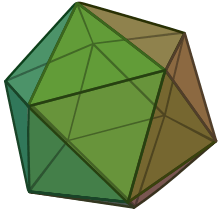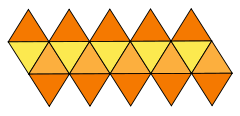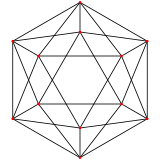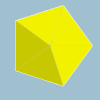Petrie polygon
In geometry, a Petrie polygon for a regular polytope of n dimensions is a skew polygon in which every (n – 1) consecutive sides (but no n) belongs to one of the facets. The Petrie polygon of a regular polygon is the regular polygon itself; that of a regular polyhedron is a skew polygon such that every two consecutive side (but no three) belongs to one of the faces.[1]
For every regular polytope there exists an orthogonal projection onto a plane such that one Petrie polygon becomes a regular polygon with the remainder of the projection interior to it. The plane in question is the Coxeter plane of the symmetry group of the polygon, and the number of sides, h, is Coxeter number of the Coxeter group. These polygons and projected graphs are useful in visualizing symmetric structure of the higher-dimensional regular polytopes.
Petrie polygons can be defined more generally for any embedded graph. They form the faces of another embedding of the same graph, usually on a different surface, called the Petrie dual.[2]
History
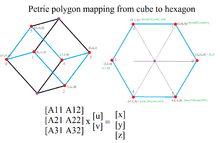
John Flinders Petrie (1907–1972) was the only son of Egyptologist Flinders Petrie. He was born in 1907 and as a schoolboy showed remarkable promise of mathematical ability. In periods of intense concentration he could answer questions about complicated four-dimensional objects by visualizing them.
He first noted the importance of the regular skew polygons which appear on the surface of regular polyhedra and higher polytopes. Coxeter explained in 1937 how he and Petrie began to expand the classical subject of regular polyhedra:
- One day in 1926, J. F. Petrie told me with much excitement that he had discovered two new regular polyhedral; infinite but free of false vertices. When my incredulity had begun to subside, he described them to me: one consisting of squares, six at each vertex, and one consisting of hexagons, four at each vertex.[3]
In 1938 Petrie collaborated with Coxeter, Patrick du Val, and H.T. Flather to produce The Fifty-Nine Icosahedra for publication.[4] Realizing the geometric facility of the skew polygons used by Petrie, Coxeter named them after his friend when he wrote Regular Polytopes.
The idea of Petrie polygons was later extended to semiregular polytopes.
The Petrie polygons of the regular polyhedra
The Petrie polygon of the regular polyhedron {p, q} has h sides, where
- h + 2 = 24/(10 − p − q).[5]
The regular duals, {p,q} and {q,p}, are contained within the same projected Petrie polygon.
| Square | Hexagon | Decagon | ||
|---|---|---|---|---|
 | ||||
| tetrahedron | cube | octahedron | dodecahedron | icosahedron |
| edge-centered | vertex-centered | face-centered | face-centered | vertex-centered |
| V:(4,0) | V:(6,2) | V:(6,0) | V:(10,10,0) | V:(10,2) |
| The Petrie polygons are the exterior of these orthogonal projections. Blue show "front" edges, while black lines show back edges. The concentric rings of vertices are counted starting from the outside working inwards with a notation: V:(a, b, ...), ending in zero if there are no central vertices. | ||||
The regular Kepler–Poinsot polyhedra have hexagonal, {6}, and decagrammic, {10/3}, Petrie polygons.
| Hexagon | Decagram | ||
|---|---|---|---|
 |
 |
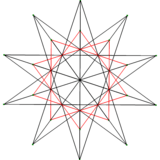 |
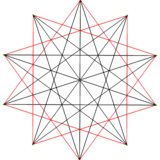 |
| {5,5/2} | {5,5/2} | {5/2,3} | {3,5/2} |
Infinite regular skew polygons (apeirogon) can also be defined as being the Petrie polygons of the regular tilings, having angles of 90, 120, and 60 degrees of their square, hexagon and triangular faces respectively.
Infinite regular skew polygons also exist as Petrie polygons of the regular hyperbolic tilings, like the order-7 triangular tiling, {3,7}:
The Petrie polygon of regular polychora (4-polytopes)
The Petrie polygon for the regular polychora {p, q ,r} can also be determined.
 {3,3,3} 5-cell 5 sides V:(5,0) |
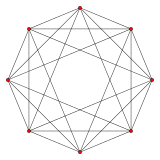 {3,3,4} 16-cell 8 sides V:(8,0) |
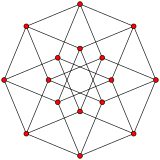 {4,3,3} tesseract 8 sides V:(8,8,0) |
 {3,4,3} 24-cell 12 sides V:(12,6,6,0) |
 {5,3,3} 120-cell 30 sides V:((30,60)3,603,30,60,0) |
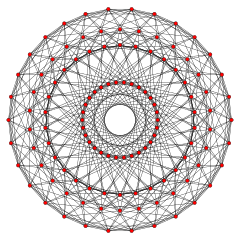 {3,3,5} 600-cell 30 sides V:(30,30,30,30,0) |
The Petrie polygon projections of regular and uniform polytopes
The Petrie polygon projections are most useful for visualization of polytopes of dimension four and higher. This table represents Petrie polygon projections of 3 regular families (simplex, hypercube, orthoplex), and the exceptional Lie group En which generate semiregular and uniform polytopes for dimensions 4 to 8.
| Table of irreducible polytope families | ||||||||||||||||
|---|---|---|---|---|---|---|---|---|---|---|---|---|---|---|---|---|
| Family n |
n-simplex | n-hypercube | n-orthoplex | n-demicube | 1k2 | 2k1 | k21 | pentagonal polytope | ||||||||
| Group | An | Bn |
|
|
Hn | |||||||||||
| 2 | 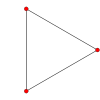 |
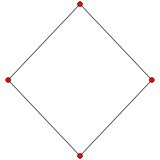 |
 p-gon (example: p=7) |
 Hexagon |
 Pentagon | |||||||||||
| 3 |  Tetrahedron |
 Cube |
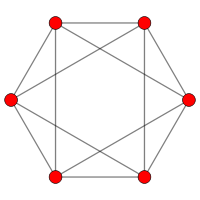 Octahedron |
 Tetrahedron |
 Dodecahedron |
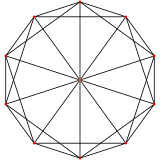 Icosahedron | ||||||||||
| 4 |  5-cell |
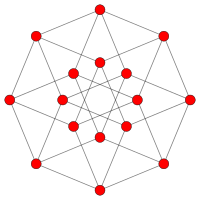 |
 16-cell |
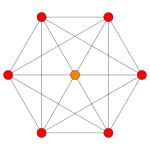 |
 24-cell |
 120-cell |
 600-cell | |||||||||
| 5 | 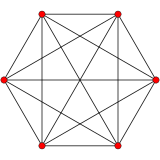 5-simplex |
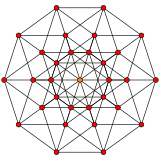 5-cube |
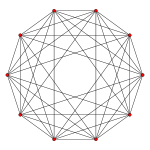 5-orthoplex |
 5-demicube |
||||||||||||
| 6 |  6-simplex |
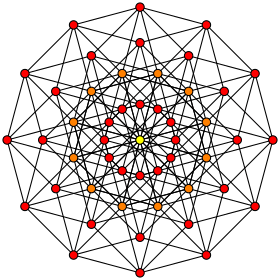 6-cube |
 6-orthoplex |
 6-demicube |
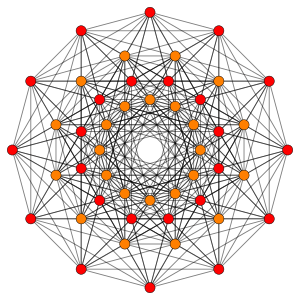 122 |
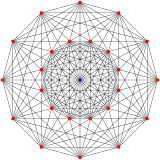 221 |
||||||||||
| 7 |  7-simplex |
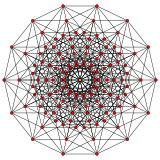 7-cube |
 7-orthoplex |
 7-demicube |
 132 |
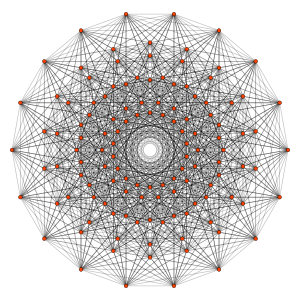 231 |
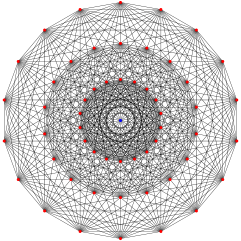 321 |
|||||||||
| 8 |  8-simplex |
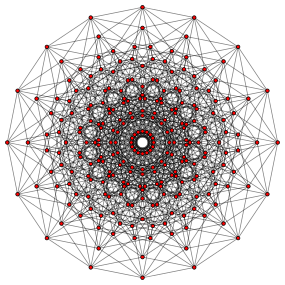 8-cube |
 8-orthoplex |
 8-demicube |
 142 |
 241 |
 421 |
|||||||||
| 9 |  9-simplex |
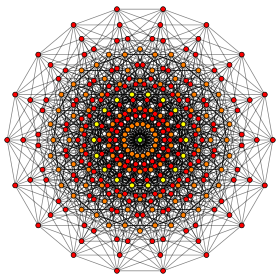 9-cube |
 9-orthoplex |
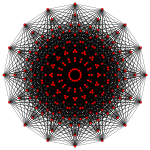 9-demicube |
||||||||||||
| 10 | 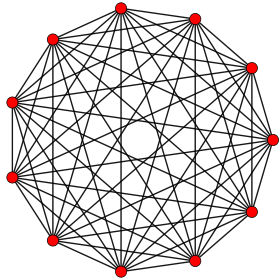 10-simplex |
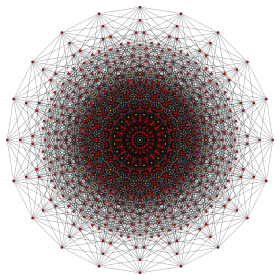 10-cube |
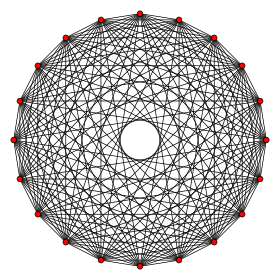 10-orthoplex |
 10-demicube |
||||||||||||
Notes
- ↑ Kaleidoscopes: Selected Writings of H. S. M. Coxeter, edited by F. Arthur Sherk, Peter McMullen, Anthony C. Thompson, Asia Ivic Weiss, Wiley-Interscience Publication, 1995, ISBN 978-0-471-01003-6 (Definition: paper 13, Discrete groups generated by reflections, 1933, p. 161)
- ↑ Gorini, Catherine A. (2000), Geometry at Work, MAA Notes, 53, Cambridge University Press, p. 181, ISBN 9780883851647
- ↑ H.S.M. Coxeter (1937) "Regular skew polyhedral in three and four dimensions and their topological analogues", Proceedings of the London Mathematical Society (2) 43: 33 to 62
- ↑ H. S. M. Coxeter, Patrick du Val, H.T. Flather, J.F. Petrie (1938) The Fifty-nine Icosahedra, University of Toronto studies, mathematical series 6: 1–26
- ↑ http://cms.math.ca/openaccess/cjm/v10/cjm1958v10.0220-0221.pdf
References
- Coxeter, H. S. M. (1947, 63, 73) Regular Polytopes, 3rd ed. New York: Dover, 1973. (sec 2.6 Petrie Polygons pp. 24–25, and Chapter 12, pp. 213–235, The generalized Petrie polygon )
- Coxeter, H.S.M. (1974) Regular complex polytopes. Section 4.3 Flags and Orthoschemes, Section 11.3 Petrie polygons
- Ball, W. W. R. and H. S. M. Coxeter (1987) Mathematical Recreations and Essays, 13th ed. New York: Dover. (p. 135)
- Coxeter, H. S. M. (1999) The Beauty of Geometry: Twelve Essays, Dover Publications LCCN 99-35678
- Peter McMullen, Egon Schulte (2002) Abstract Regular Polytopes, Cambridge University Press. ISBN 0-521-81496-0
- Steinberg, Robert,ON THE NUMBER OF SIDES OF A PETRIE POLYGON
External links
- Weisstein, Eric W. "Petrie polygon". MathWorld.
- Weisstein, Eric W. "Hypercube graphs". MathWorld.
- Weisstein, Eric W. "Cross polytope graphs". MathWorld.
- Weisstein, Eric W. "24-cell graph". MathWorld.
- Weisstein, Eric W. "120-cell graph". MathWorld.
- Weisstein, Eric W. "600-cell graph". MathWorld.
- Weisstein, Eric W. "Gosset graph 3_21". MathWorld.
Fundamental convex regular and uniform polytopes in dimensions 2–10 | ||||||||||||
|---|---|---|---|---|---|---|---|---|---|---|---|---|
| Family | An | Bn | I2(p) / Dn | E6 / E7 / E8 / F4 / G2 | Hn | |||||||
| Regular polygon | Triangle | Square | p-gon | Hexagon | Pentagon | |||||||
| Uniform polyhedron | Tetrahedron | Octahedron • Cube | Demicube | Dodecahedron • Icosahedron | ||||||||
| Uniform 4-polytope | 5-cell | 16-cell • Tesseract | Demitesseract | 24-cell | 120-cell • 600-cell | |||||||
| Uniform 5-polytope | 5-simplex | 5-orthoplex • 5-cube | 5-demicube | |||||||||
| Uniform 6-polytope | 6-simplex | 6-orthoplex • 6-cube | 6-demicube | 122 • 221 | ||||||||
| Uniform 7-polytope | 7-simplex | 7-orthoplex • 7-cube | 7-demicube | 132 • 231 • 321 | ||||||||
| Uniform 8-polytope | 8-simplex | 8-orthoplex • 8-cube | 8-demicube | 142 • 241 • 421 | ||||||||
| Uniform 9-polytope | 9-simplex | 9-orthoplex • 9-cube | 9-demicube | |||||||||
| Uniform 10-polytope | 10-simplex | 10-orthoplex • 10-cube | 10-demicube | |||||||||
| Uniform n-polytope | n-simplex | n-orthoplex • n-cube | n-demicube | 1k2 • 2k1 • k21 | n-pentagonal polytope | |||||||
| Topics: Polytope families • Regular polytope • List of regular polytopes and compounds | ||||||||||||
